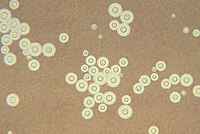
Photo from wikipedia
In Space, cosmic radiation is a strong, ubiquitous form of energy with constant flux, and the ability to harness it could greatly enhance the energy-autonomy of expeditions across the solar… Click to show full abstract
In Space, cosmic radiation is a strong, ubiquitous form of energy with constant flux, and the ability to harness it could greatly enhance the energy-autonomy of expeditions across the solar system. At the same time, radiation is the greatest permanent health risk for humans venturing into deep space. To protect astronauts beyond Earth's magnetosphere, advanced shielding against ionizing as well as non-ionizing radiation is highly sought after. In search of innovative solutions to these challenges, biotechnology appeals with suitability for in situ resource utilization (ISRU), self-regeneration, and adaptability. Where other organisms fail, certain microscopic fungi thrive in high-radiation environments on Earth, showing high radioresistance. The adaptation of some of these molds to areas, such as the Chernobyl Exclusion Zone has coined the terms positive “radiotropism” and “radiotrophy”, reflecting the affinity to and stimulation by radiation, and sometimes even enhanced growth under ionizing conditions. These abilities may be mediated by the pigment melanin, many forms of which also have radioprotective properties. The expectation is that these capabilities are extendable to radiation in space. To study its growth in space, an experiment cultivating Cladosporium sphaerospermum Penzig ATCC® 11289™ aboard the International Space Station (ISS) was conducted while monitoring radiation beneath the formed biomass in comparison to a no-growth negative control. A qualitative growth advantage in space was observable. Quantitatively, a 1.21 ± 0.37-times higher growth rate than in the ground control was determined, which might indicate a radioadaptive response to space radiation. In addition, a reduction in radiation compared to the negative control was discernable, which is potentially attributable to the fungal biomass.
Journal Title: Frontiers in Microbiology
Year Published: 2022
Link to full text (if available)
Share on Social Media: Sign Up to like & get
recommendations!